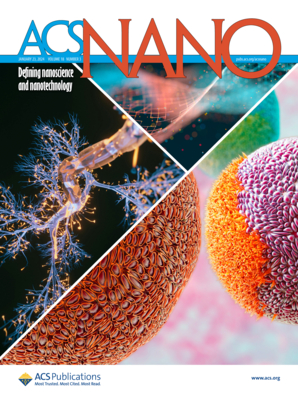3D Tunnel Copper Tetrathiovanadate Nanocube Cathode Achieving Ultrafast Magnesium Storage Reactions through a Charge Delocalization and Displacement Mechanism
IF 15.8
1区 材料科学
Q1 CHEMISTRY, MULTIDISCIPLINARY
引用次数: 0
Abstract
Rechargeable magnesium batteries are attractive candidates for large-scale energy storage applications because of the low cost and high safety, but the scarcity and inferior performance of the cathode materials are hindering the development. In the present study, a kind of copper tetrathiovanadate (Cu3VS4) cathode is designed and developed with a comprehensive consideration of the chemical and electronic structures. The vanadium and sulfur atoms form chemical bonds with high covalent proportion, facilitating electron delocalization via the vanadium–sulfur bonds. This reduces the interaction with the bivalent magnesium cation and induces the coredox of vanadium and sulfur. The crystal structure of Cu3VS4 has interlaced 3D tunnels for solid-state magnesium cation transport. The Cu3VS4 cathode shows a high capacity of 350 mA h g–1 at 100 mA g–1, an outstanding rate performance of 67 mA h g–1 at 10 A g–1, and stable cycling for 1000 cycles at 5 A g–1 without obvious capacity fading. Prominently, a high areal mass load of 3.5 mg cm–2 could be achieved without obvious rate capability decay, which is quite favorable to pair with the high-capacity magnesium metal anode in practical application. The mechanism investigation and theoretical computation demonstrate that Cu3VS4 undergoes first a magnesium intercalation and then a displacement reaction, during which the crystal structure is maintained, assisting the reaction reversibility and cycling stability. All the copper, vanadium, and sulfur elements experience redox and contribute to the high capacity. Moreover, the weakened interaction with magnesium cations, well-kept 3D cation transport tunnels, and high electronic conductivity result in the superior rate performance and high areal active material loading. The present study develops a high-performance cathode for rechargeable magnesium batteries and reveal the design principle based on both of chemical and electronic structures.

三维隧道式四硫杂钒酸铜纳米立方体阴极通过电荷析出和位移机制实现超快镁存储反应
可充电镁电池因成本低、安全性高而成为大规模储能应用的理想候选材料,但阴极材料的稀缺性和低劣性能阻碍了其发展。本研究综合考虑了化学结构和电子结构,设计并开发了一种四硫杂钒酸铜(Cu3VS4)阴极。钒原子和硫原子形成了高共价比例的化学键,有利于电子通过钒硫键脱ocal。这就减少了与二价镁阳离子的相互作用,诱导了钒和硫的羰基氧化。Cu3VS4 的晶体结构具有用于固态镁阳离子传输的交错三维隧道。Cu3VS4 阴极在 100 mA g-1 电流条件下显示出 350 mA h g-1 的高容量,在 10 A g-1 电流条件下显示出 67 mA h g-1 的出色速率性能,在 5 A g-1 电流条件下可稳定循环 1000 次而无明显容量衰减。更突出的是,在实现 3.5 mg cm-2 的高面积质量负载时也没有明显的速率能力衰减,这对于在实际应用中与高容量镁金属阳极配对是相当有利的。机理研究和理论计算表明,Cu3VS4 首先发生镁插层反应,然后发生置换反应,在此过程中晶体结构得以保持,从而提高了反应的可逆性和循环稳定性。所有的铜、钒和硫元素都发生了氧化还原反应,从而产生了高容量。此外,与镁阳离子的相互作用减弱、三维阳离子传输通道保持良好、电子传导性高,这些都造就了卓越的速率性能和高面积活性材料负载。本研究为可充电镁电池开发了一种高性能阴极,并揭示了基于化学结构和电子结构的设计原理。
本文章由计算机程序翻译,如有差异,请以英文原文为准。
求助全文
约1分钟内获得全文
求助全文
来源期刊

ACS Nano
工程技术-材料科学:综合
CiteScore
26.00
自引率
4.10%
发文量
1627
审稿时长
1.7 months
期刊介绍:
ACS Nano, published monthly, serves as an international forum for comprehensive articles on nanoscience and nanotechnology research at the intersections of chemistry, biology, materials science, physics, and engineering. The journal fosters communication among scientists in these communities, facilitating collaboration, new research opportunities, and advancements through discoveries. ACS Nano covers synthesis, assembly, characterization, theory, and simulation of nanostructures, nanobiotechnology, nanofabrication, methods and tools for nanoscience and nanotechnology, and self- and directed-assembly. Alongside original research articles, it offers thorough reviews, perspectives on cutting-edge research, and discussions envisioning the future of nanoscience and nanotechnology.
 求助内容:
求助内容: 应助结果提醒方式:
应助结果提醒方式:


